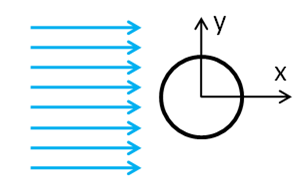| HTML |
|---|
<div style="background-color: yellow; border: 2px solid red; margin: 4px; padding: 2px; font-weight: bold; text-align: center;">
This page has been moved to <a href="https://courses.ansys.com/index.php/courses/unsteady-flow-past-a-cylinder/">https://courses.ansys.com/index.php/courses/unsteady-flow-past-a-cylinder/</a>
<br>
Click in the link above if you are not automatically redirected in 10 seconds.
</div>
<meta http-equiv="refresh" content="10; URL='https://courses.ansys.com/index.php/courses/unsteady-flow-past-a-cylinder/'" /> |
| Include Page | ||||
|---|---|---|---|---|
|
| Include Page | ||||
|---|---|---|---|---|
|
Unsteady Flow Past a Cylinder
Created using ANSYS 13.0
Problem Specification
Consider the unsteady state case of a fluid flowing past a cylinder, as illustrated above. For this tutorial we will use a Reynolds Number of 120. In order to simplify the computation, the diameter of the cylinder is set to 1 m, the x component of the velocity is set to 1 m/s and the density of the fluid is set to 1 kg/m^3. Thus, the dynamic viscosity must be set to 8.333x10^-3 kg/m*s in order to obtain the desired Reynolds number.
Compared to the steady case, the unsteady case includes an additional time-derivative term in the Navier-Stokes equations:
| Latex |
|---|
| Wiki Markup |
{include: FLUENT Google Analytics} {include: Unsteady Flow Past a Cylinder - Panel} h1. Unsteady Flow Past a Cylinder Created using ANSYS 13.0 h2. Problem Specification \\ !prob_spec_v2.png!\\ \\ Consider the unsteady state case of a fluid flowing past a cylinder, as illustrated above. For this tutorial we will use a Reynolds Number of 120. In order to simplify the computation, the diameter of the cylinder is set to 1 m, the x component of the velocity is set to 1 m/s and the density of the fluid is set to 1 kg/m^3. Thus, the dynamic viscosity must be set to 8.333x10^-3 kg/m*s in order to obtain the desired Reynolds number. Compared to the steady case, the unsteady case includes an additional time-derivative term in the Navier-Stokes equations: {latex} \begin{eqnarray} \frac{\partial \vec{u}}{\partial t} + \rho (\vec{u}\cdot \triangledown)\vec{u} = -\triangledown p + \mu \triangledown^{2} \vec{u} \end{eqnarray} {latex} |
The
...
methods
...
implemented
...
by
...
FLUENT
...
to
...
solve
...
a
...
time
...
dependent
...
system
...
are
...
very
...
similar
...
to
...
those
...
used
...
in
...
a
...
steady-state
...
case.
...
In this case,
...
the
...
domain
...
and
...
boundary
...
conditions
...
will
...
be
...
the
...
same
...
as
...
the
...
Steady
...
Flow
...
Past
...
a
...
Cylinder.
...
However,
...
because
...
this
...
is
...
a
...
transient
...
system,
...
initial
...
conditions
...
at
...
t=0
...
are
...
required.
...
To solve the system,
...
we
...
need
...
to
...
input
...
the
...
desired
...
time
...
range
...
and
...
time
...
step
...
into
...
FLUENT.
...
The program will then compute a solution for the first time step, iterating until convergence or a limit of iterations is reached, then will proceed to the next time step, "marching" through time until the end time is reached.
Go to Step 1: Pre-Analysis & Start-Up
 Sign-up for free online course on ANSYS simulations!
Sign-up for free online course on ANSYS simulations!